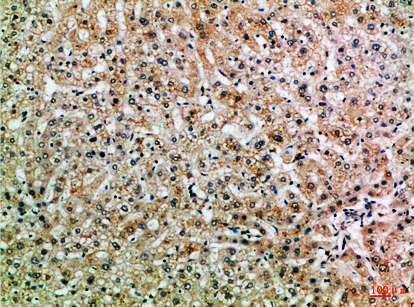ASPP1 Polyclonal Antibody
- Catalog No.:YT6010
- Applications:IHC;IF;ELISA
- Reactivity:Human;Mouse
- Target:
- ASPP1
- Gene Name:
- PPP1R13B ASPP1 KIAA0771
- Protein Name:
- Apoptosis-stimulating of p53 protein 1 (Protein phosphatase 1 regulatory subunit 13B)
- Human Gene Id:
- 23368
- Human Swiss Prot No:
- Q96KQ4
- Mouse Gene Id:
- 21981
- Mouse Swiss Prot No:
- Q62415
- Immunogen:
- Synthetic peptide from human protein at AA range: 630-680
- Specificity:
- The antibody detects endogenous ASPP1
- Formulation:
- Liquid in PBS containing 50% glycerol, 0.5% BSA and 0.02% sodium azide.
- Source:
- Polyclonal, Rabbit,IgG
- Dilution:
- IHC 1:50-200, ELISA 1:10000-20000. IF 1:50-200
- Purification:
- The antibody was affinity-purified from rabbit antiserum by affinity-chromatography using epitope-specific immunogen.
- Concentration:
- 1 mg/ml
- Storage Stability:
- -15°C to -25°C/1 year(Do not lower than -25°C)
- Other Name:
- Apoptosis-stimulating of p53 protein 1 (Protein phosphatase 1 regulatory subunit 13B)
- Background:
- This gene encodes a member of the ASPP (apoptosis-stimulating protein of p53) family of p53 interacting proteins. The protein contains four ankyrin repeats and an SH3 domain involved in protein-protein interactions. ASPP proteins are required for the induction of apoptosis by p53-family proteins. They promote DNA binding and transactivation of p53-family proteins on the promoters of proapoptotic genes. Expression of this gene is regulated by the E2F transcription factor. [provided by RefSeq, Jul 2008],
- Function:
- disease:Defects in PPP1R13B may be a cause of breast cancers. It is overexpressed in many patients suffering from breast carcinomas and expressing a wild-type TP53 protein.,domain:The ankyrin repeats and the SH3 domain are required for specific interactions with TP53.,function:Regulator that plays a central role in regulation of apoptosis via its interaction with p53/TP53. Regulates TP53 by enhancing the DNA binding and transactivation function of TP53 on the promoters of proapoptotic genes in vivo.,miscellaneous:In contrast to its official gene name, it is not a regulatory subunit of protein phosphatase 1. This name was given due to its similarity with a protein that binds to protein phosphatase 1.,similarity:Belongs to the ASPP family.,similarity:Contains 1 SH3 domain.,similarity:Contains 2 ANK repeats.,subcellular location:Predominantly cytoplasmic. Some fraction is nuclear.,subunit:I
- Subcellular Location:
- Cytoplasm . Nucleus . Predominantly cytoplasmic. Some fraction is nuclear.
- Expression:
- Reduced expression in breast carcinomas expressing a wild-type TP53 protein.
- June 19-2018
- WESTERN IMMUNOBLOTTING PROTOCOL
- June 19-2018
- IMMUNOHISTOCHEMISTRY-PARAFFIN PROTOCOL
- June 19-2018
- IMMUNOFLUORESCENCE PROTOCOL
- September 08-2020
- FLOW-CYTOMEYRT-PROTOCOL
- May 20-2022
- Cell-Based ELISA│解您多样本WB检测之困扰
- July 13-2018
- CELL-BASED-ELISA-PROTOCOL-FOR-ACETYL-PROTEIN
- July 13-2018
- CELL-BASED-ELISA-PROTOCOL-FOR-PHOSPHO-PROTEIN
- July 13-2018
- Antibody-FAQs
- Products Images

- Immunohistochemical analysis of paraffin-embedded Human-liver, antibody was diluted at 1:100



